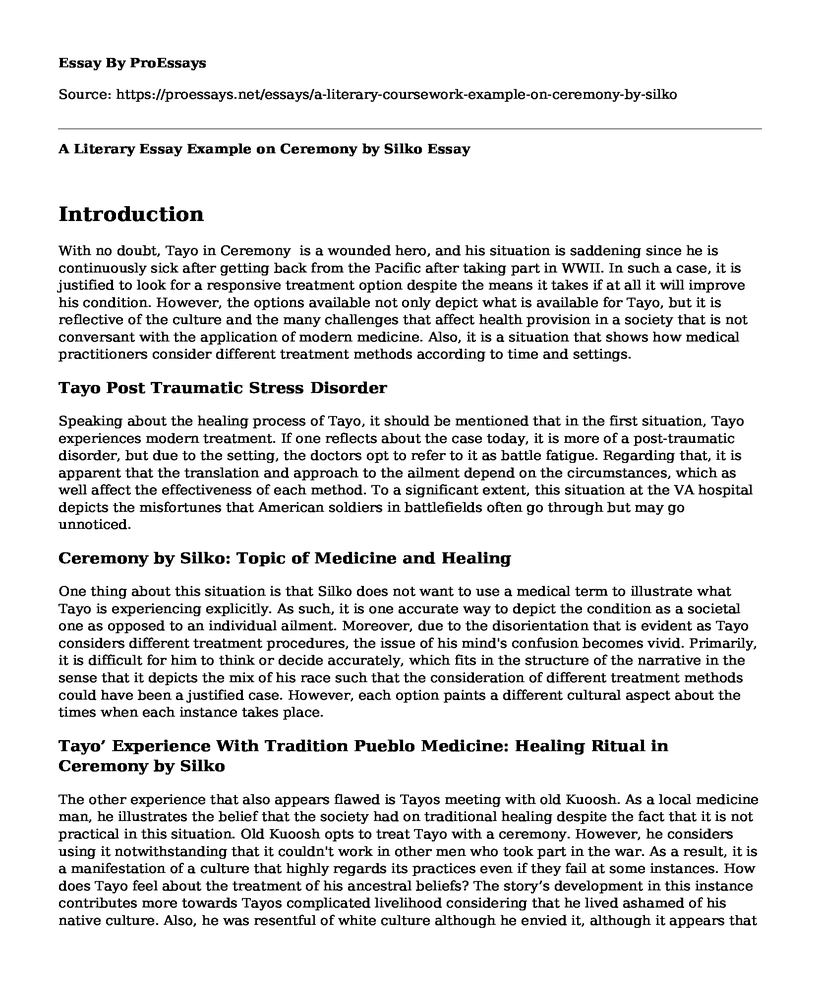Introduction
With no doubt, Tayo in Ceremony is a wounded hero, and his situation is saddening since he is continuously sick after getting back from the Pacific after taking part in WWII. In such a case, it is justified to look for a responsive treatment option despite the means it takes if at all it will improve his condition. However, the options available not only depict what is available for Tayo, but it is reflective of the culture and the many challenges that affect health provision in a society that is not conversant with the application of modern medicine. Also, it is a situation that shows how medical practitioners consider different treatment methods according to time and settings.
Tayo Post Traumatic Stress Disorder
Speaking about the healing process of Tayo, it should be mentioned that in the first situation, Tayo experiences modern treatment. If one reflects about the case today, it is more of a post-traumatic disorder, but due to the setting, the doctors opt to refer to it as battle fatigue. Regarding that, it is apparent that the translation and approach to the ailment depend on the circumstances, which as well affect the effectiveness of each method. To a significant extent, this situation at the VA hospital depicts the misfortunes that American soldiers in battlefields often go through but may go unnoticed.
Ceremony by Silko: Topic of Medicine and Healing
One thing about this situation is that Silko does not want to use a medical term to illustrate what Tayo is experiencing explicitly. As such, it is one accurate way to depict the condition as a societal one as opposed to an individual ailment. Moreover, due to the disorientation that is evident as Tayo considers different treatment procedures, the issue of his mind's confusion becomes vivid. Primarily, it is difficult for him to think or decide accurately, which fits in the structure of the narrative in the sense that it depicts the mix of his race such that the consideration of different treatment methods could have been a justified case. However, each option paints a different cultural aspect about the times when each instance takes place.
Tayo’ Experience With Tradition Pueblo Medicine: Healing Ritual in Ceremony by Silko
The other experience that also appears flawed is Tayos meeting with old Kuoosh. As a local medicine man, he illustrates the belief that the society had on traditional healing despite the fact that it is not practical in this situation. Old Kuoosh opts to treat Tayo with a ceremony. However, he considers using it notwithstanding that it couldn't work in other men who took part in the war. As a result, it is a manifestation of a culture that highly regards its practices even if they fail at some instances. How does Tayo feel about the treatment of his ancestral beliefs? The story’s development in this instance contributes more towards Tayos complicated livelihood considering that he lived ashamed of his native culture. Also, he was resentful of white culture although he envied it, although it appears that it is his people who stood by him during the challenging times.
Tayo and His Friends
The most significant part of Tayos experience appears to be the time that he is spending with his friends. As a disappointed person after a traumatizing service, he interacts with others in a drinking spree with the hope that such activities contain therapeutic values. Apparently, it is not Tayos great determination to consider drinking; it is because it provides a soothing option out of the agony that has found a way into his life. As the story depicts peoples experience with beer, it accurately shows that loving people doesn't come naturally; thus, it comes from other influences such as medical attachment or cultural encouragement.
Conclusion
In summation, the three primary paths that Tayo takes as treatment options seem to have different shortcomings, but each has a unique translation when attached to social values. By and large, it is a case reflection that reveals the numerous paradoxes present in the medical field and the different challenges that people face as time frames and situations change. However, all these experiences do not reduce the importance of culture, but they keep reminding people about their journey to the present day and the significance of various social practices, that is one of Ceremony by silko themes.
References
Silko, L. M. (1986). Ceremony. New York, N.Y: Penguin Books.
Cite this page
A Literary Essay Example on Ceremony by Silko. (2021, Sep 02). Retrieved from https://proessays.net/essays/a-literary-coursework-example-on-ceremony-by-silko
If you are the original author of this essay and no longer wish to have it published on the ProEssays website, please click below to request its removal:
- Essay on Comparing Two Translations of Heine's Poem
- Assignment Example on Ancient Egyptian Literature
- Case Study: Slavery in Africa
- Essay Example on Percy Jackson and the Lightning Thief: Literary Analysis
- American Realism: A Faithful Representation of Reality - Essay Sample
- Essay Example on the Grotesque in Ordinary: The Lottery & Omelas
- Essay Example on Here Come the Sun: Struggles of Life in Jamaica's River Bank







